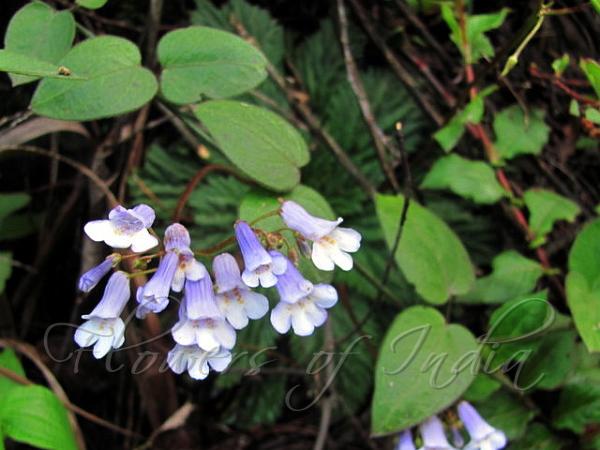|
| Blue Stone Flower |
|

|

| File size | 76101 |
| Original date | 4/30/12 4:01 PM |
| Resolution | 640 x 480 |
| Flash | Flash did not fire, auto |
| Focal length | 6.0mm |
| Exposure time | 1/50s |
| Aperture | 2.8 |
| Focus Distance | |
| Metering Mode | Multi-segment |
| Camera make | Canon |
| Camera model | Canon PowerShot SX120 IS |
| Sensor type | OneChipColorArea |
|
|
|
|
Photo: |
Botanical name: Corallodiscus lanuginosus Family: Gesneriaceae (Gloxinia family)
Synonyms: Didissandra lanuginosa, Didymocarpus lanuginosus
Synonyms: Didissandra lanuginosa, Didymocarpus lanuginosus
Blue Stone Flower is a perennial herb found growing
on rocks. Leaves are many, in a compact basal rosette, hairless to
densely woolly, blade broadly lanceshaped, obovate, rhombic,
elliptical, or round, base broadly or narrowly wedge-shaped, veins
prominent. Flowers are borne in cymes in leaf axils, one- to
many-flowered, lax, bracteoles apparently absent. Sepals are free
nearly to base or fused halfway. Flowers are tubular, blue to purple,
with 2-lipped limb. Upper lip is 2-lobed, shorter than 3-lobed lower
lip, lobes nearly equal, rounded or obtuse. Lower lip has dense beard
inside of tube. Color can be rarely yellow or white. Stamens are 4,
inserted above flower base (rarely above middle), included or slightly
protruding, anthers dorsifixed, coherent in pairs. Nectary is
ring-like. Ovary oblong, with 2 parietal placentae; stigma capitate.
Capsule is usually oblong to linear, much longer than calyx, splitting
open. Blue Stone Flower is found in China, Bhutan, N. India, Nepal,
Sikkim and Thailand, at altitudes of 700-4300 m. Flowering: April-October.
Medicinal uses:  In Tibetan medicine, it is believed to cure poisoning, diarrhoea caused
by hot diseases and disorders of kidney. Leaves are the part which is
used.
In Tibetan medicine, it is believed to cure poisoning, diarrhoea caused
by hot diseases and disorders of kidney. Leaves are the part which is
used.
 In Tibetan medicine, it is believed to cure poisoning, diarrhoea caused
by hot diseases and disorders of kidney. Leaves are the part which is
used.
In Tibetan medicine, it is believed to cure poisoning, diarrhoea caused
by hot diseases and disorders of kidney. Leaves are the part which is
used. | Identification credit: H.B. Naithani | Photographed in Walong, Arunachal Pradesh. |
• Is this flower misidentified? If yes,